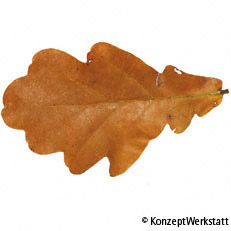Common Oak, English Oak, Pedunculate Oak (Quercus robur)
The English Oak is a majestic large tree growing to 30-40m. The thick branches are often gnarled. The leaves are obovate to elliptic and appear late. Solitary old trees characterize entire landscapes.
Giftigkeit
All parts of the plant, especially unripe acorns, contain tanning agents and are therefore toxic. Tanning agents may lead to endogastritis, vomiting and diarrhoea.
Anwendung
Open country, open fields, pioneer tree, tip afforestation, stabilization of shores and hillsides, noise abatement, wind-break, bird protection, parks, urban areas, roadside verges, car parks, pedestrian precincts
Heimatgebiete
Central Europe, Southern Europe, Asia Minor, Balkans, Mediterranean countries, Caucasus, North Africa
Standortparameter
Light: full sun to off-sun, temperature: warm to cool, soil: dry to fresh, stagnant moisture: resistant, soil structure: firm to normal, soil depth: very deep, compaction: resistant, soil quality: medium, pH value: 6.0 to 8.0
Ansprüche
Sun to slight shade; likes warmth, frost-hardy, dry to moist, undemanding and robust; all nutrient-rich substrates; resistant to urban climates and wind; moderately tolerant of salt
unknown
Height of growth: 30m to 40m, spread:15m to 25m, moderately rapid growth potential, growth habits: loose, spreading
Blätter
Deeply pinnate-lobed, widely rounded lobes, 10-15cm long, 5-10cm wide, leaf stem 0.2-0.8cm long. Leaves are glossy green above, pale blue-green below, turn brown in autumn.
Blüten
Flowering period IV-V, yellow--green male flowers in pendent clusters of catkins. Female flowers singly or in ear-like clusters at the tips of young shoots.
Früchte
Brown oblong stalked acorns half-seated in closely scaled cups, up to 3.5cm long. Acorns on stalks 5-12cm long.
Rinde
Dark grey bark with deep furrows. Branches are olive green or pale grey.
Wurzel
Taprooter








